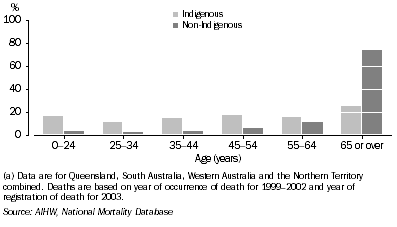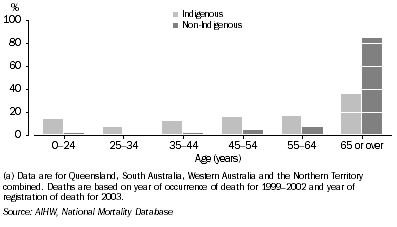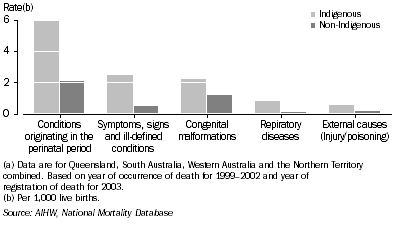For the period 1999-2003, there were 7,387 registered deaths identified as Indigenous (4,222 males and 3,165 females) for persons reported to have been usual residents of Queensland, South Australia, Western Australia and the Northern Territory. These deaths accounted for 3.2% of all deaths of usual residents in these four jurisdictions, and 71% of all identified Aboriginal and Torres Strait Islander deaths in Australia.
Age at death
In Queensland, South Australia, Western Australia and the Northern Territory, 75% of Indigenous males and 65% of Indigenous females died before the age of 65 years. This is in stark contrast to the non-Indigenous population where only 26% of males and 16% of females who died were aged less than 65 years (graphs 9.1 and 9.2).
Infant deaths (deaths under one year) contribute to the younger age at death of the Indigenous population. For the period 1999-2003, Indigenous infant deaths represented 6.2% of total Indigenous male deaths and 6.5% of total Indigenous female deaths, compared with 0.9% and 0.8% of the total for non-Indigenous male and female infant deaths.
The 35-44 year age group accounted for 15% of total Indigenous male deaths compared with only 3% of total non-Indigenous male deaths, while the 45-54 year age group accounted for 16% of Indigenous female deaths compared with 4% of total non-Indigenous female deaths.
9.1 Male deaths, by Indigenous status and age - 1999-2003(a)
 9.2 Female deaths, by Indigenous status and age - 1999-2003(a)
9.2 Female deaths, by Indigenous status and age - 1999-2003(a)

Indigenous Australians were over-represented in almost every age group. Table 9.3 shows Indigenous deaths as a proportion of total deaths by age group in 1999-2003 and their respective proportions of the total population for the same period.
9.3 Deaths of Indigenous persons in Qld, SA, WA and NT(a) - 1999-2003 |
|  |
 | Number of Indigenous deaths (no.) | Indigenous deaths as a proportion of total deaths (%) | Indigenous persons as a proportion of total population (%)(b) |  |
| Age (years) | Males | Females | Males | Females | Males | Females |  |
|  |
| Less than 1 | 263 | 206 | 19.0 | 19.3 | 7.6 | 7.7 |  |
| 1-4 | 48 | 45 | 13.7 | 19.6 | 7.3 | 7.5 |  |
| 5-14 | 56 | 43 | 13.8 | 14.2 | 6.8 | 6.7 |  |
| 15-24 | 306 | 133 | 12.1 | 14.9 | 4.9 | 5.2 |  |
| 25-34 | 462 | 226 | 13.2 | 16.6 | 4.0 | 4.4 |  |
| 35-44 | 636 | 380 | 13.7 | 14.3 | 2.9 | 3.1 |  |
| 45-54 | 723 | 490 | 9.1 | 9.9 | 2.0 | 2.2 |  |
| 55-64 | 651 | 509 | 4.7 | 6.5 | 1.4 | 1.7 |  |
| 65 or over | 1 058 | 1 118 | 1.2 | 1.4 | 0.9 | 0.9 |  |
| Total(c) | 4 222 | 3 165 | 4.3 | 3.6 | 3.7 | 3.8 |  |
|  |
| (a) Data for Queensland, South Australia, Western Australia and the Northern Territory combined. Deaths are based on year of occurrence of death for 1999-2002 and year of registration of death for 2003. |
| (b) Estimates of the Indigenous population for 1999-2003 are based on the 2001 Census. |
| (c) Includes deaths where age was not stated. |
| AIHW, National Mortality Database |
Infant deaths-main causes
Infant deaths are deaths of live-born children which occur before they reach their first birthday. In 1999-2003, for Indigenous infants, the mortality rate was three times that of non-Indigenous infants (table 9.5). Almost half (45%) of total infant deaths were due to conditions originating in the perinatal period - conditions related to the foetus and newborn affected by complications of pregnancy, labour and delivery; and disorders related to length of gestation and foetal growth. Symptoms, signs and ill-defined conditions, including sudden infant death syndrome (SIDS), were responsible for 19% of infant deaths and congenital malformations accounted for 16%. For respiratory diseases (6%) and external causes (mainly accidents) (5%), the mortality rates for Indigenous infants were ten and four times, respectively, those of non-Indigenous infants (graph 9.4 ).
9.4 Infant deaths, main causes(a), by Indigenous status - 1999-2003

Age-specific death rates
In Queensland, South Australia, Western Australia and the Northern Territory, age-specific death rates for Indigenous males and females across almost all age groups were higher than the rates for non-Indigenous males and females in these jurisdictions. For all age groups below 65 years, the age-specific death rates for Indigenous Australians were at least twice those experienced by the non-Indigenous population. The greatest differences occurred among those in the 35-44 and 45-54 year age groups, where the rates for Indigenous males and females were five times those recorded for non-Indigenous males and females (table 9.5).
9.5 Age-specific death rates(a), by sex and Indigenous status - 1999-2003 |
|  |
 | Males | Females |  |
| Age (years) | Indigenous rate(b) | Non-Indigenous rate(b) | Rate ratio(c) | Indigenous rate(b) | Non-Indigenous rate(b) | Rate ratio(c) |  |
|  |
| Less than 1(d) | 15 | 5 | 3.0 | 12 | 4 | 3.0 |  |
| 1-4 | 66 | 31 | 2.1 | 64 | 20 | 3.2 |  |
| 5-14 | 31 | 14 | 2.2 | 25 | 11 | 2.3 |  |
| 15-24 | 239 | 87 | 2.7 | 103 | 31 | 3.3 |  |
| 25-34 | 432 | 115 | 3.8 | 195 | 44 | 4.4 |  |
| 35-44 | 791 | 146 | 5.4 | 436 | 82 | 5.3 |  |
| 45-54 | 1 443 | 288 | 5.0 | 907 | 179 | 5.1 |  |
| 55-64 | 2 667 | 760 | 3.5 | 1 784 | 438 | 4.1 |  |
| 65 or over | 6 273 | 4 534 | 1.4 | 5 093 | 3 763 | 1.4 |  |
|  |
| (a) Data for Queensland, South Australia, Western Australia and the Northern Territory combined. Deaths are based on year of occurrence of death for 1999-2002 and year of registration of death for 2003. |
| (b) Per 100,000 population. |
| (c) Rate for Indigenous Australians divided by the rate for non-Indigenous Australians. |
| (d) Per 1,000 live births. |
| AIHW, National Mortality Database |
In the age groups in which differences in death rates between Indigenous and non-Indigenous populations are greatest (35-54 years), ischaemic heart disease, diseases of the liver (i.e. alcoholic liver disease and cirrhosis of the liver), diabetes and intentional self-harm are major causes of death (table 9.6). Indigenous males and females aged 35-54 years died from diabetes at 21 and 37 times the rates, and from influenza and pneumonia at 20 and 17 times the rates, of non-Indigenous males and females of the same age for these conditions. While some of these rates have been derived from a relatively small number of deaths - for example deaths caused by mental and behavioural disorders due to psychoactive substance use totalled only 11 deaths among Indigenous females over the five year period 1999-2003 - differences between the two population groups are still striking.
9.6 Age-specific death rates by major causes(a)(b) - persons aged 35-54 years - 1999-2003 |
|  |
 | Indigenous | Non-Indigenous | Rate ratio(c) |  |
 | Males | Females | Males | Females | Males | Females |  |
|  |
| Ischaemic heart disease (I20-I25) | 237.5 | 102.7 | 33.1 | 6.2 | 7.2 | 16.6 |  |
| Diabetes (E10-E14) | 73.6 | 56.7 | 3.5 | 1.5 | 21.2 | 37.3 |  |
| Disease of liver (K70-K77) | 69.0 | 45.3 | 8.3 | 3.1 | 8.3 | 14.7 |  |
| Other forms of heart disease (I30-I52) | 45.2 | 18.4 | 5.4 | 2.3 | 8.3 | 8.2 |  |
| Intentional self harm (X60-X84) | 45.2 | 7.8 | 27.6 | 7.9 | 1.6 | 1.0 |  |
| Mental and behavioural disorders due to psychoactive substance use (F10-F19) | 40.6 | 7.8 | 3.0 | 0.7 | 13.7 | 11.1 |  |
| Malignant neoplasm of digestive organs (C15-C26) | 36.8 | 15.6 | 19.2 | 12.5 | 1.9 | 1.2 |  |
| Chronic lower respiratory disease (J40-J47) | 35.2 | 26.2 | 2.5 | 2.7 | 13.9 | 9.7 |  |
| Influenza and pneumonia (J10-J18) | 32.2 | 12.0 | 1.6 | 0.7 | 19.9 | 16.7 |  |
| Assault (X85-Y09) | 31.4 | 12.7 | 1.9 | 1.0 | 17.0 | 12.4 |  |
| Cerebrovascular disease (I60-I69) | 30.6 | 27.6 | 5.8 | 5.1 | 5.3 | 5.4 |  |
| Malignant neoplasm of respiratory and intrathoracic organs (C30-C39) | 30.6 | 19.1 | 13.1 | 8.6 | 2.3 | 2.2 |  |
| Ill-defined and unknown causes of mortality (R95-R99) | 26.1 | 10.6 | 3.1 | 1.2 | 8.5 | 8.8 |  |
| Car occupant injured in transport accident (V40-V49) | 25.3 | 11.3 | 5.9 | 3.3 | 4.3 | 3.5 |  |
| Pedestrian injured in transport accident (V01-V09) | 20.7 | 12.0 | 1.6 | 0.3 | 13.0 | 38.7 |  |
|  |
| (a) Per 100,000 population. |
| (b) Data for Queensland, South Australia, Western Australia and the Northern Territory combined. Deaths are based on year of occurrence of death for 1999-2002 and year of registration of death for 2003. Disease groupings are based on three-digit groupings of ICD-10. |
| (c) Rate for Indigenous Australians divided by the rate for non-Indigenous Australians. |
| AIHW, National Mortality Database |
 Print Page
Print Page
 Print All
Print All